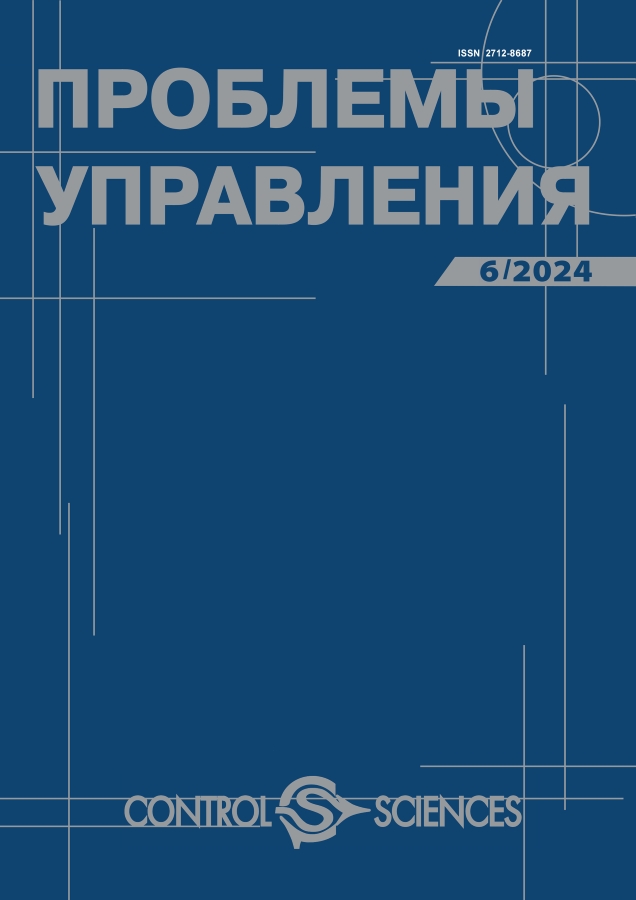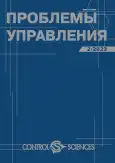Methods for Solving Some Problems of Air Traffic Planning and Regulation. Part II: Application of Deep Reinforcement Learning
- Authors: Kulida E.L1, Lebedev V.G1
-
Affiliations:
- Trapeznikov Institute of Control Sciences, Russian Academy of Sciences
- Issue: No 2 (2023)
- Pages: 3-18
- Section: Surveys
- URL: https://bakhtiniada.ru/1819-3161/article/view/291581
- DOI: https://doi.org/10.25728/pu.2023.2.1
- ID: 291581
Cite item
Full Text
Abstract
About the authors
E. L Kulida
Trapeznikov Institute of Control Sciences, Russian Academy of SciencesMoscow, Russia
V. G Lebedev
Trapeznikov Institute of Control Sciences, Russian Academy of SciencesMoscow, Russia
References
- Кулида Е.Л., Лебедев В.Г. Методы решения задач планирования и регулирования потоков воздушного движения. Ч. 1. Стратегическое планирование четырехмерных траекторий // Проблемы управления. – 2023. – № 1. – С. 3–14. [Kulida, E.L. and Lebedev, V.G. Methods for Solving Some Problems of Air Traffic Planning and Regulation. Part I: Strategic Planning of 4D Trajectories // Control Sciences. – 2023. – No. 1. – P. 2–11.]
- Degas, A., Islam, M.R., Hurter, C., et al. A Survey on Artificial Intelligence (AI) and eXplainable AI in Air Traffic Management: Current Trends and Development with Future Research Trajectory // Applied Sciences. – 2022. – Vol. 12, no. 3. – Art. no. 1295. – doi: 10.3390/app12031295.
- Wang, Z., Pan, W., Li, H., et al. Review of Deep Reinforcement Learning Approaches for Conflict Resolution in Air Traffic Control // Aerospace. – 2022. – Vol. 9, no. 6. – Art. no. 294. – doi: 10.3390/aerospace9060294.
- Brittain, M., Wei, P. Autonomous Aircraft Sequencing and Separation with Hierarchical Deep Reinforcement Learning // Proceedings of the 8th International Conference on Research in Air Transportation. – Barcelona, Spain, 2018. – URL: https://www.reseachgate.net/publication/327287314.
- Pham, D.T., Tran, N.P., Alam, S., et al. A Machine Learning Approach for Conflict Resolution in Dense Traffic Scenarios with Uncertainties // ATM 2019, 13th USA/Europe Air Traffic Management Research and Development Seminar. – Vienne, 2019.
- Pham, D.T., Tran, N.P., Alam, S., et. al. Deep Reinforcement Learning based Path Stretch Vector Resolution in Dense Trac with Uncertainties // Transportation Research. Part C. Emerging Technologies. – 2021. – Vol. 135. – Art. no. 103463. – doi: 10.1016/j.trc.2021.103463.
- Tran, P.N., Pham, D.T., Goh, S.K., et al. An Interactive Conflict Solver for Learning Air Traffic Conflict Resolutions // Journal of Aerospace Information Systems. – 2020. – Vol. 17, no. 6. – P. 271–277.
- Ribeiro, M., Ellerbroek, J., Hoekstra J. Improvement of Conflict Detection and Resolution at High Densities through Reinforcement Learning // Proceedings of the International Conference on Research in Air Transportation. – Tampa, USA, 2020.
- Brittain, M., Wei, P. Autonomous Separation Assurance in an High-Density en Route Sector: A Deep Multi-Agent Reinforcement Learning Approach // IEEE Intelligent Transportation Systems Conference (ITSC). – Aukland, New Zealand, 2019. – P. 3256–3262.
- Brittain, M., Yang, X., Wei, P. A Deep Multi-Agent Reinforcement Learning Approach to Autonomous Separation Assurance // Arxiv:2003.08353v2. – 2020. – DOI: https://doi.org/10.48550/arXiv.2003.08353.
- Brittain, M., Wei, P. One to Any: Distributed Conflict Resolution with Deep Multi-Agent Reinforcement Learning and Long Short-Term Memory // AIAA Scitech 2021 Forum. – Nashville, 2021. – P. 1952.
- Zhao, P., Liu, Y. Physics Informed Deep Reinforcement Learning for Aircraft Conflict Resolution // IEEE Transactions on Intelligent Transportation Systems. – 2021. –Vol. 23, iss. 7. – P. 8288–8301. – doi: 10.1109/TITS.2021.3077572.
- Mollinga, J.; Hoof, H. An Autonomous Free Airspace En-route Controller Using Deep Reinforcement Learning Techniques // Arxiv:2007.01599. – 2020. – DOI: https://doi.org/10.48550/arXiv.2007.01599.
- Khan, N.A., Brohi, S.N., Jhanjhi, N. UAV’s Applications, Architecture, Security Issues and Attack Scenarios: A Survey // Intelligent Computing and Innovation on Data Science. – 2020. – Vol. 183. – P. 753–760. – doi: 10.1007/978-981-15-3284-9_86.
- Szegedy, C., Zaremba, W., Sutskever, I., et al. Intriguing Properties of Neural Networks // Arxiv:1312.6199v3. – 2013. – DOI: https://doi.org/10.48550/arXiv.1312.6199.
- Athalye, A., Engstrom, L., Ilyas, A., Kwok, K. Synthesizing Robust Adversarial Examples // International Conference on Machine Learning. – Stockholm, 2018. – P. 284–293.
- Wang, L., Yang, H., Lin, Y., et al. Explainable and Safe Reinforcement Learning for Autonomous Air Mobility // arXiv:2211.13474v1. – 2022. – DOI: https://doi.org/10.48550/arXiv.2211.13474.
- Messaoud, M. A Thorough Review of Aircraft Landing Operation from Practical and Theoretical Standpoints at an Airport Which May Include a Single or Multiple Runways // Applied Soft Computing. – 2020. – Vol. 98, no. 12. – Art. no. 106853. – doi: 10.1016/j.asoc.2020.106853.
- Sutton, R.S., Barto, A.G. Reinforcement Learning: An Introduction. – London, UK: MIT Press, 2017.
- Degris, T., Pilarski, P.M., Sutton, R.S. Model-Free Reinforcement Learning with Continuous Action in Practice // American Control Conf., Fairmont Queen. – Elizabeth, Montréal, Canada, 2012. – P. 2177–2182.
- LeCun, Y., Bengio, Y., Hinton, G. Deep Learning // Nature. – 2015. – Vol. 521. – P. 436–444.
- Sutton, R.S., McAllester, D.A., Singh, S.P., et al. Policy Gradient Methods for Reinforcement Learning with Function Approximation // Advances in Neural Information Processing Systems. – USA, Denver, MIT Press, 1999. – P. 1057–1063.
- Wang, Z., Li, H., Wang, J., Shen, F. Deep Reinforcement Learning Based Conflict Detection and Resolution in Air Traffic Control // IET Intelligent Transport System. – 2019. – Vol. 13. – P. 1041–1047.
- Juntama, P., Delahaye, D., Chaimatanan, S., Alam, S. Hyperheuristic Approach Based on Reinforcement Learning for Air Traffic Complexity Mitigation // Journal of Aerospace Information Systems. – 2022. – Vol. 19, no. 9. – doi: 10.2514/1.i011048.
- Вишнякова Л.В., Попов А.С. Выбор структуры воздушного пространства и инфраструктуры аэродромов при их модернизации методами математического моделирования // Известия РАН. Теория и системы управления. – 2021. – № 6. – С. 66 – 105. [Vishnyakova, L.V., Popov, A.S. Vybor struktury vozdushnogo prostranstva i infrastruktury aerodromov pri ih moder-nizacii metodami matematicheskogo modelirovaniya // Izve-stiya RAN. Teoriya i sistemy upravleniya. – 2021. – No. 6. – P. 66 – 105. (In Russian)]
- Bennell, J.A. Mesgarpour, M. Potts, C.N. Airport Runway Scheduling // Semantic Scholar. – 2011. – Vol. 4OR. – P. 115–138. – doi: 10.1007/s10288-011-0172-x .
- Prakash, R. Piplani, R. Desai, J. An Optimal Data-Splitting Algorithm for Aircraft Scheduling on a Single Runway to Maximize Throughput // Transportation Research, Part C: Emerging Technologies. – 2018. – Vol. 95. – P. 570– 581.
- Dear, R.G. The Dynamic Scheduling of Aircraft in the Near Terminal Area // Technical Report, R76-9, Flight Transportation Laboratory. – MIT, Cambridge, MA, USA, 1976.
- Кулида Е.Л. Генетический алгоритм решения задачи оптимизации последовательности и времен посадок воздушных судов // Автоматика и телемеханика. – 2022. – № 3. – С. 156–168. [Kulida, E.L. Genetic Algorithm for Solving the Problem of Optimizing Aircraft Landing Sequence and Times // Automation and Remote Control. – 2022. – Vol. 83, no. 3. – P. 426–436.]
- Кулида Е.Л., Лебедев В.Г., Егоров Н.А. Сравнение двух алгоритмов решения задачи оптимизации последовательности и времен посадок воздушных судов // В сборнике: Управление развитием крупномасштабных систем (MLSD'2021). Труды Четырнадцатой международной конференции. – Москва. – 2021. – С. 1438–1444. [Kulida E., Egorov N., Lebedev V. Comparison of Two Algorithms for Solving the Problem Aircraft Arrival Sequencing and Scheduling / Proceedings of the 14th International Conference «Management of Large-Scale System Development» (MLSD). – IEEE, 2021. – URL: https://ieeexplore.ieee.org/document/9600243.]
- Вересников Г.С., Кулида Е.Л., Егоров Н.А., Лебедев В.Г. Методы построения оптимальных очередей воздушных судов на посадку. Ч. 1. Методы точного решения // Проблемы управления. – 2018. – № 4. – С. 2–14. [Veresnikov, G.S., Egorov, N.A. Kulida, E.L., Lebedev, V.G. Methods for Solving of the Aircraft Landing Problem. I. Exact Solution Methods. // Automation and Remote Control. – 2019. – Vol. 80. – P. 1317–1334.]
- Вересников Г.С., Егоров Н.А., Кулида Е.Л., Лебедев В.Г. Методы построения оптимальных очередей воздушных судов на посадку [1]. Ч. 2. Методы приближенного решения // Проблемы управления. – 2018. – № 5. – С. 2–13. [Veresnikov, G.S., Egorov, N.A. Kulida, E.L., Lebedev, V.G. Methods for Solving of the Aircraft Landing Problem. II. Approximate Solution Methods // Automation and Remote Control. – 2019. – Vol. 80. – P. 1502–1518.]
- Soares, I. B., De Hauwere, Y.M., Januarius, K., et al. Departure Management with a Reinforcement Learning Approach: Respecting CFMU Slots // IEEE 18th International Conference on Intelligent Transportation Systems. – Las Palmas de Gran Canaria, Spain. 2015.
- Watkins, C. J. Dayan, P. Q-learning // Machine Learning. – 1992. – Vol. 8. – P. 279–292.
- Brittain, M. Wei, P. Autonomous Aircraft Sequencing and Separation with Hierarchical Deep Reinforcement Learning // Proceedings of the International Conference for Research in Air Transportation. – Barcelona, Spain. 2018.
- Colen, J. NASA sector 33 application. – 2013. – URL: https://www.nasa.gov/ centers/ames/Sector33/iOS/index.html.
- Henry, A., Delahaye, D., Valenzuela, A. Conflict Resolution with Time Constraints in the Terminal Maneuvering Area Using a Distributed Q-learning Algorithm // International Conference on Research in Air Transportation (ICRAT 2022). – 2022. – Tampa, USA. – Hal-03701660.
- Ma, J., Delahaye, D., Sbihi, M., Mongeau, M. Integrated Optimization of Terminal Manoeuvring Area and Airport // 6th SESAR Innovation Days. – Delft, Netherlands, 2016.
Supplementary files











